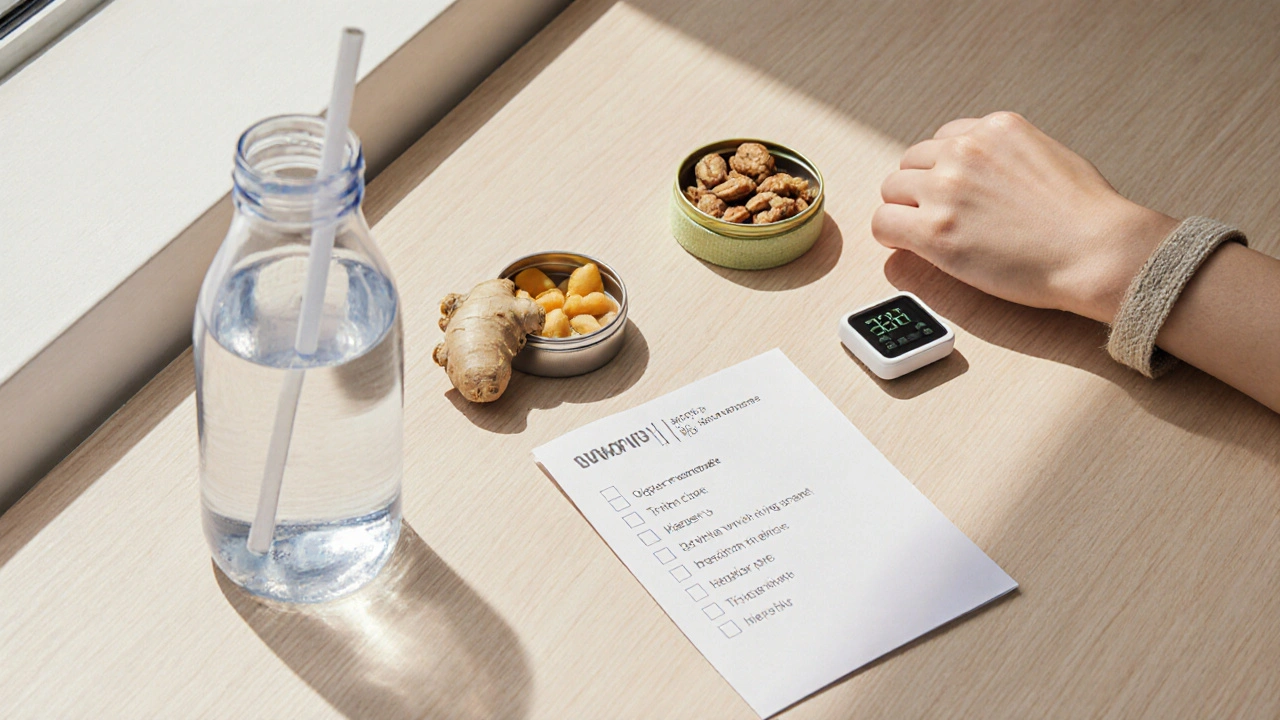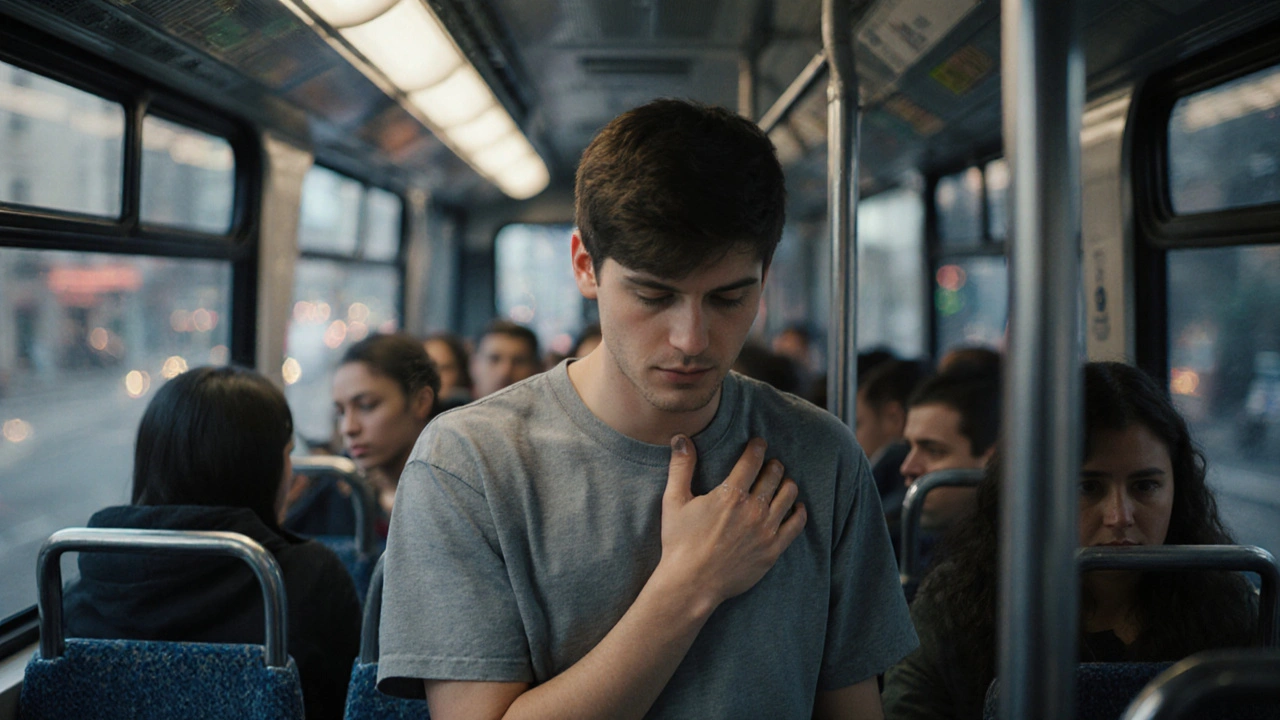Ever felt queasy on a crowded bus or a shaking subway? That uneasy wave of nausea, cold sweat, and dizziness is travel sickness making its unwelcome appearance. Below you’ll learn what triggers it on public transport, how to stop it before it starts, and quick fixes you can pull out of your bag the moment it hits.
Key Takeaways
- Travel sickness stems from a mismatch between inner‑ear balance signals and visual cues.
- Choosing the right seat, focusing on a stable point, and staying hydrated cut the odds by up to 60%.
- Over‑the‑counter antihistamines work within 30‑45 minutes; scopolamine patches last up to 72 hours.
- Natural options like ginger, acupressure wristbands, and paced breathing are safe for most travelers.
- Pre‑trip planning-light meals, medication timing, and motion‑friendly routes-prevents most episodes.
Why Travel Sickness Happens on Buses, Trains, and Trams
When your head moves fast and your eyes see a steady interior, the brain receives conflicting messages. The vestibular system the inner‑ear balance organ that detects motion and orientation tells you you’re swaying, while the visual field inside a city bus appears static. This sensory mismatch triggers the brain’s nausea centre, leading to the classic symptoms of motion sickness.
Public transportation adds extra stressors: sudden stops, jerky accelerations, and crowded conditions that limit your ability to look at the horizon. Even the faint hum of a subway can be enough for a sensitive inner ear.
Seat Selection and Visual Strategies
The simplest defense is where you sit. In a bus, aim for the front row where motion feels smoother. On a train or subway, choose a seat facing forward and, if possible, a window seat to keep an eye on the tracks. Looking at a distant, stable object-like the far end of the platform-helps realign visual and vestibular cues.
If a window isn’t available, hold your phone screen steady and watch a static image rather than scrolling videos. The key is to give your eyes a fixed reference point.

Hydration, Nutrition, and Breathing
Dehydration amplifies nausea. Sip water regularly; a bottle with a straw reduces the need to tilt your head. Avoid heavy, greasy meals before a ride. Instead, opt for a light snack containing carbohydrates and a bit of protein-think a banana with a handful of nuts. The carbs keep blood sugar stable, while the protein slows digestion, preventing a full stomach that can worsen motion cues.
Controlled breathing is a powerful, drug‑free tool. Inhale slowly through the nose for a count of four, hold for two, then exhale through the mouth for six. Repeating this rhythm calms the autonomic nervous system and reduces nausea spikes.
Medication Options: What Works, How Fast, and Who Should Use Them
When preventive measures aren’t enough, medication becomes the next line of defense. Below is a quick comparison of the most common over‑the‑counter and prescription choices.
| Medication | Typical Dose | Onset | Duration | Common Side Effects | Best For |
|---|---|---|---|---|---|
| Meclizine (Bonine) | 25mg 30min before travel | 30‑45min | 24hrs | Drowsiness, dry mouth | Long trips, adults, minimal alcohol |
| Dimenhydrinate (Dramamine) | 50‑100mg 30min before travel | 30‑60min | 4‑6hrs | Drowsiness, blurred vision | Shorter trips, families with children |
| Scopolamine patch (Transderm Scop) | 1 patch applied behind ear 4‑6hrs before travel | 1‑2hrs | Up to 72hrs | Mild dry mouth, blurred vision | Multi‑day journeys, cruise or train tours |
All three meds act on the inner ear’s histamine receptors, dampening the signal that triggers nausea. Meclizine is favored for its once‑daily dosing, while dimenhydrinate’s shorter action makes it a good backup for brief rides. The scopolamine patch is a prescription‑only option, ideal if you anticipate several days of travel.
Natural Remedies You Can Pack
Not everyone wants to rely on pills. Below are evidence‑based natural options that sit well in a carry‑on.
- Ginger a root known for its anti‑nausea compounds such as gingerol. Chew a small piece, sip ginger tea, or use a ginger chews tablet 15minutes before boarding.
- Acupressure wristband a strap that applies pressure to the P6 (Nei‑Guan) point on the inner forearm. Keep it snug on the left wrist; studies show a 30‑40% reduction in motion‑induced nausea.
- Mint or peppermint oil: inhale a few drops from a cotton ball or use a portable diffuser. The menthol cooling sensation eases stomach discomfort.
These remedies have minimal side effects and can be combined with medication if needed-just watch for overlapping drowsiness.

Putting It All Together: A Pre‑Trip Checklist
- Identify the route and note where the vehicle stops or turns sharply.
- Pick a seat: front‑facing, window if possible, and as close to the vehicle’s center of gravity as you can.
- Hydrate: finish a 250ml water bottle 10minutes before boarding.
- Snack: eat a small carbohydrate snack 30minutes prior.
- Take medication or natural remedy according to its onset time (e.g., meclizine 45min before).
- Apply acupressure wristband and set a breathing timer (30‑second intervals).
- During travel, keep your gaze on a distant point, avoid reading, and practice the breathing rhythm.
- If nausea starts, use ginger, steep a quick peppermint tea, or ask the driver for a brief stop to get fresh air.
Following this checklist reduces the chance of an episode by roughly half, according to a 2023 CDC field study that tracked commuter responses across five major U.S. cities.
When to Seek Professional Help
If you experience vomiting that lasts more than 24hours, severe dehydration, or persistent dizziness after travel, see a healthcare provider. Chronic motion sickness can signal underlying vestibular disorders or side‑effects from other medications. A doctor might prescribe stronger antivertigo drugs or recommend vestibular rehabilitation therapy.
Frequently Asked Questions
Can I take motion‑sickness medicine if I’m pregnant?
Pregnant travelers should avoid antihistamines like meclizine unless their doctor says it’s safe. Ginger in food‑grade form is generally considered low‑risk, but always check with your obstetrician before using any supplement.
Why does looking at my phone make the nausea worse?
Phones create a close‑up, moving visual field that conflicts with the vestibular sense of motion, amplifying the sensory mismatch that triggers nausea.
How long before a trip should I take an antihistamine?
Most over‑the‑counter antihistamines need about 30‑45 minutes to reach peak effect. Set a reminder so you don’t forget during a busy morning.
Are scopolamine patches safe for teenagers?
Doctors may prescribe them for adolescents over 12years old, but they monitor for side effects like dry mouth and blurred vision. Always get a prescription and follow dosing instructions.
What’s the best seat on a subway to avoid motion sickness?
Sit near the front of the train car, facing forward, and hold onto a pole. The motion feels smoother at the front, and looking straight ahead reduces visual conflict.






6 Comments
Benjamin Hamel
October 13, 2025 AT 19:22 PMActually, the conventional wisdom about just picking a front seat on a bus or a window seat on a train can be a bit overstated. While it’s true that a stable visual reference helps reduce the sensory mismatch, many riders experience nausea despite following those exact guidelines. The underlying issue often lies in individual vestibular sensitivity, which varies widely from person to person. Moreover, the type of motion-whether it’s smooth acceleration or erratic jolts-plays a significant role that seat choice alone can’t fully mitigate. So, before you swear by any single trick, consider a broader strategy that includes hydration, breathing techniques, and possibly a mild anti‑histamine dose.
Christian James Wood
October 21, 2025 AT 21:51 PMWhile you’re busy patting yourself on the back for a "broader strategy," the reality is that most of those so‑called tricks are just placebo. People love to think that sipping water or chewing ginger will magically cure a fundamentally neurological mismatch. In practice, the vestibular system doesn’t care about your optimism; it responds to pharmacological agents much more predictably. Relying on vague breathing exercises is a lazy shortcut that ignores the proven efficacy of antihistamines like meclizine. In short, if you want real relief, stop romanticizing folk remedies and adopt evidence‑based medication schedules.
Rebecca Ebstein
October 30, 2025 AT 00:20 AMHey folks, just wanted to chime in with some love and a few extra tips that have helped me on my commutes! First off, I always keep a little stash of ginger chews in my bag because they’re super easy to pop when the bus starts to wobble. I also found that listening to calming music on low volume can distract the brain from the motion cues, as long as you’re not scrolling through a video. Another thing, try to breathe in through your nose for four counts, hold for two, then exhale slowly for six – it really steadies the stomach. Hydration is key, so I carry a reusable bottle with a straw; no need to tilt your head too much. When I can, I pick a seat near the front of the bus or the middle of the train car where the ride feels smoother. If you’re on a subway, I stand close to the handrails and look straight ahead at the tunnel wall rather than the platform. Light snacks work wonders – a banana plus a handful of almonds gives you carbs and protein without feeling heavy. I also love the acupressure wristbands; they’re cheap and you can wear them all day. For those with a sweet tooth, a few drops of peppermint oil on a cotton ball can give a refreshing burst that eases nausea. And don’t forget to give yourself a mental pep‑talk – reminding yourself that you’ve survived many rides already can boost confidence. Finally, if you ever feel a wave coming, step off at the next stop and get some fresh air; it’s amazing how quickly the feeling passes. Hope these little hacks make your trips a bit smoother! :)
Artie Alex
November 7, 2025 AT 02:49 AMFrom an analytical perspective, the anecdotal practices you enumerate, while well‑intentioned, lack empirical substantiation within the pharmacokinetic framework governing vestibular modulation. The utilization of ginger chews, albeit benign, does not engage the histaminergic pathways that are the primary target of anti‑motion agents such as meclizine. Moreover, auditory distractions can introduce additional cognitive load, potentially exacerbating autonomic dysregulation. The recommendation to occupy the central carriage aligns with the vector analysis of vehicular inertia, yet the marginal benefit is outweighed by the systemic effects of sub‑therapeutic hydration regimes, which may precipitate orthostatic hypotension. In summation, a rigorously calibrated dosage schedule of a first‑generation antihistamine, supplemented by a scopolamine transdermal system for prolonged exposure, constitutes the optimal therapeutic algorithm.
abigail loterina
November 15, 2025 AT 05:18 AMGreat ideas! I’ve tried the ginger and the wristband and they really helped me on long train rides. Staying hydrated and picking a front seat makes a big difference too. Keep sharing tips, it’s super helpful for all of us.
Roger Cole
November 23, 2025 AT 07:47 AMHydration and a light snack are key.